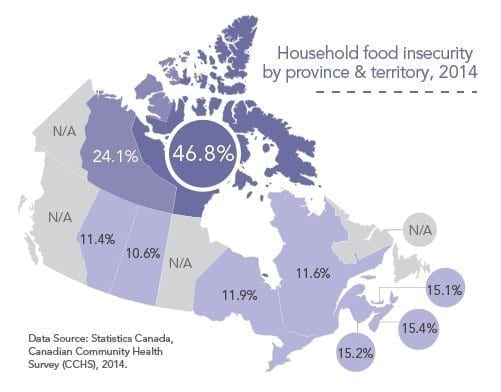Food insecurity in Nunavut's 10 largest communities rose by 13.5 per cent during the transition to Nutrition North Canada, which offers subsidies to retailers, from the Food Mail Program, which offered subsidies for shipping via Canada Post.

Michele LeTourneau/NNSL photo
This hike in the percentage of food insecure households from 33.1 to 46.6 per cent took place between 2010 and 2014, according to the study titled Food Insecurity in Nunavut Following the Introduction of Nutrition North Canada, published May 21 in the Canadian Medical Association Journal.
"If anything, this is an underestimate," said Andrée-Anne Fafard St-Germain, who co-authored the study with Valerie Tarasuk and Tracey Galloway.
"It's the 10 largest communities. And it's not like the sample is representative, even of those 10 communities. If we were to include all 25 communities in Nunavut, we'd probably have way higher rates if we think of what came out of the Inuit health survey in 2007 with rates of 60 per cent and above."
The study – which took the authors more than two years of honing in on the available data – makes clear that people are not able to meet their food needs.
"It's a different way of saying what's been said for many years. There have been so many groups that have criticized the program and made recommendations on how to improve it. If (the program) was really effective those rates probably wouldn't be going this high, wouldn't keep creeping up," said Fafard St-Germain
The study does not definitively state the program is to blame.
"But we wouldn't expect things to be getting worse," she said.
"The government is saying there's more and more food being shipped to those communities. How can that be true while we see rising rates of food insecurity? How can those two things co-exist at the same time? Well, we don't really know who is accessing that food. Is it possible it's a very specific segment of the population accessing that food, while for the other segment things are just getting worse?"

photo courtesy PROOF Food Insecurity Policy Research
Fafard St-Germain makes the point that just because Nutrition North does bring the costs of some foods down, it doesn't mean people can afford to buy it. She also says a program like Nutrition North can't be expected to bring Nunavut food insecurity rates down to the national level.
The authors are interested in determinants and consequences of food insecurity, and their relationship to policy initiatives.
Fafard St-Germain says Nutrition North is the only federal initiative in the country that aims specifically to improve people's ability to afford and access food.
"Food Mail had been in place for a very long time. It's kind of a landmark in policy landscape, for the North especially," she said.
She adds the hope is the study can be an advocacy tool.
"To say, 'We really need Nutrition North to be evaluated against a more tangible outcome, something that is more meaningful in terms of people's ability to put food on their table,'" she said.
"This kind of model of food subsidy has been in place for over 50 years, the Food Mail program and then Nutrition North. The rates of food insecurity have always been very high … and worse now. Maybe it's time we move past a food subsidy program, and start thinking of the other kind of actions that are needed to meaningfully and sustainably bring those rates of food insecurity down.
"We wanted to really bring forward this notion that we really don't know what this program is doing."
A scathing 2014 report from the Office of the Auditor General stated essentially the same thing.
See Comments sought on Nutrition North
See Waiting for Nutrition North update
The federal government held extensive consultations throughout the North beginning in 2016, and communities shared their needs and ideas. In December 2018, parliamentary secretary to the Minister of Intergovernmental and Northern Affairs and Internal Trade Yvonne Jones travelled to Iqaluit to announce changes.
Some changes were made to the $99 million program's subsidy rates and food eligibility list, but the retailer subsidy structure remained.
"I think a lot of people have a lot of ideas how to improve it, but the extent that they're really listened to is questionable," said Fafard St-Germain.